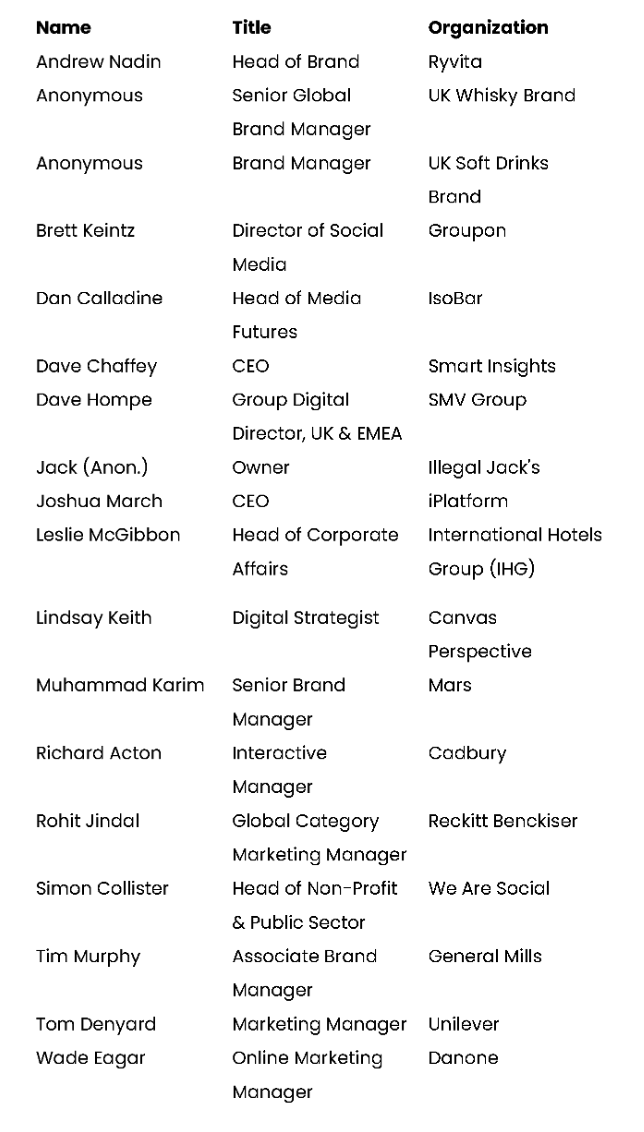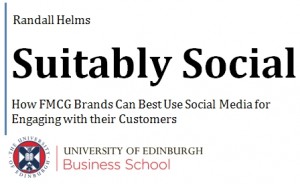MBA student Randall Helms (@sonicrampage) got in touch to let me know about his MBA dissertation for the University of Edinburgh Business School titled Suitably Social: How FCMG Brands Can Best Use Social for Engaging with their Customers.
I’ve had a quick read and it is a solid piece of work – so I am more than happy to promote it here.
For the report he managed to interview some heavy hitters – names and companies are listed below.

Report Summary: This report draws on a range of primary and secondary research, including eighteen interviews conducted in person, over the phone, and via email with a number of professionals from FMCG brands, consultancies, and digital marketing agencies.
Abstract:
Social networking is a genuine cultural phenomenon, having become the UK’s most popular online sector in less than ten years. As social media consumes ever greater amounts of leisure time, how to use this new channel effectively has become perhaps the most important question facing the marketing profession. Although social media presents challenges to all sectors, this report looks at how marketers of Fast Moving Consumer Goods (FMCG) brands can best use social media to engage with their core customers.
In answering this question, this report draws on the results of a program of primary and secondary research, including eighteen interviews conducted in July and August 2010 with professionals from a number of FMCG brands and digital and social media marketing agencies. Among the topics covered in these interviews were identifying core customers, customer engagement, defining and measuring ‘success’ in social media, using social media for market research, working with influencers, tracking the online conversation about a brand, what specific challenges FMCG brand managers face in the social space, as well as social media’s downsides for marketers.
The research showed that it is impossible for FMCG brands to segment their social media audience in order to identify their core customers. Instead, it was revealed that social media is an effective tool for engaging with a brand’s existing customers, whether ‘core’ or not, and that there are a number of best practice principles that can be utilised to help achieve a brand’s goals in the social space. Although a number of interviewees claimed that brands should only be involved in social media if they are willing to commit the proper resources, the fact that none said that their brand was better off outside the social space shows that a social media presence is no longer optional, but is instead essential to the work of the modern marketer, even for FMCG brands which, as the research showed, have not been on the cutting edge of the social media phenomenon.
Social media is more than just a marketing channel because it offers marketers a direct, unmediated connection with their customer, and this relationship can be leveraged for insights relevant to new product development and market research. This is particularly important to FMCG marketers, because social media offers them direct access to their products’ end users for the first time. This engagement can provide a better understanding both of the customer as well as what they want from the brand.
The research also uncovered a number of problems with social media, such as the difficulty of defining Return on Investment and the fact that social media can be extremely time-consuming. Furthermore, many FMCG brands face the additional hurdle of having relatively uncommitted customers due to their lack of brand resonance.
Drawing on these findings, the report then presents a series of ten best practice principles for marketers of FMCG brands wishing to work with social media:
- Set clear goals
- Establish metrics to measure success
- Understand the different social media tools
- Get closer to the customer
- Take care over the message
- Be flexible
- Identify influencers
- Invest in success
- Create a Social Media Response Centre
- Keep an open mind and don’t be afraid to fail
Note: All work in this report is the copyright (2010) of Randall Helms. This report has been made available under a Creative Commons Attribution-NoDerivs 3.0 Unported License.

